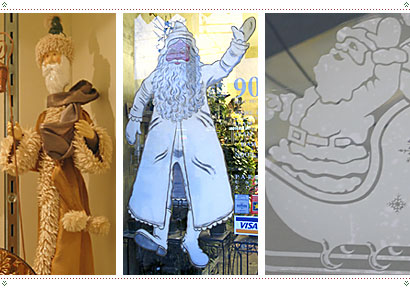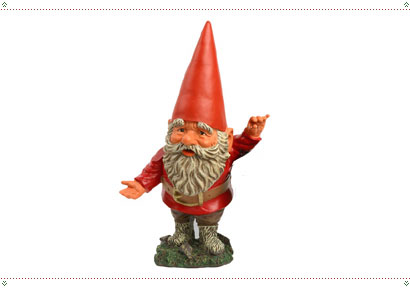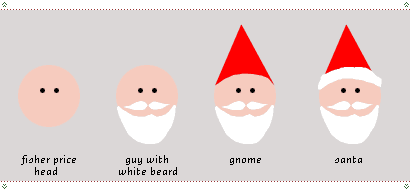We’re all spending a lot of time around Santa these days, perhaps more than we’d like and whether we like it or not. But as I wandered the store aisles this week I began to think of him in a way I never have before. No, not that way.
Santa is an icon—an icon of Commercial Christmas—and although the mythology surrounding him varies from country to country, here in North America this icon is fairly fixed within a set of graphic parameters which makes him instantly identifiable within a wide variety of alternatives.
As I looked around, I saw Santa everywhere, but I was struck by just how varied the form of Santa is while still remaining Santa.
At its most complete, the Santa set comprises of: fat older white man, white beard and moustache, red outfit and pointy hat trimmed with white fur, wide black belt, boots, mittens and assorted paraphernalia and hangers-on (sleigh, elves, reindeer, bells, sack, etc.)

These ingredients are sufficient enough that the Santa icon can appear in any number of forms or media without loss of recognition. From ceramics to felt to knitwear, you name it, Santa’s been made from it.

But the Santa icon is incredibly flexible, to the extent that almost any of the characteristics can be swapped, altered or removed and still remain recognizably Santa. Let’s start with that suit.

The Santa on the left, above, is a kind of ersatz ur-Santa. Any robed Santa makes reference to his origins as St. Nicholas but remains decidedly Santa. On the right, the popular Chocolate Santa. Robed or unrobed, delicious.

These robed Santas are pushing the boundaries of costume to the extreme. The fellow on the left is decidedly Gandalfian, the one on the right fantastic. The question is, if this were July would we still recognize these figures as Santa? I say yes. The fact that the robes are red is the dead giveaway.
So is the colour red a requirement for the icon Santa?

It would appear not. Blue, green … still Santa. And check this out:

White, or no colour at all: still Santa.
What about facial features? Beyond the beard, what constants are required for this icon to remain Santa?

None. Santa is not a character. Although traditionally fat, he can be emaciated, have giant tumours for cheeks or have, essentially, no features at all and still be recognizable at 50 paces. I didn’t see a non-caucasian Santa, but I would posit that skin colour also does not matter. Neither does gender:

How about that jolly personality?

Not required. Worried, vaguely lewd or angry: still Santa.
Is the beard necessary? Absolutely, I think so. Does it have to be white? Well, that’s debatable. This from the Dec. 6 cover of the New Yorker, by Carter Goodrich …

Hilarious.
So if we identify a red outfit, black belt, white beard, rosy cheeks and a hat, do we have Santa?

NOT. That’s a different Christmas season character. It’s the hat, right? Gotta have that pointy red hat.

That’s a garden gnome. Admittedly there is a fine line between Santa and a garden gnome (mix in a few elves and you’ve got some suspicious genetic material) but what’s clearly missing is the fur trim. It would appear that white fur trim is an essential characteristic of the Santa icon.
The following diagram shows the basic progression from not-Santa to Santa:

… and from there an infinite number of variations.
But what can we, as graphic designers, learn from this? Well, I’m about to propose a radical new thought. Anyone who has ever prepared a standards manual for a corporate identity is familiar with the concept of—if not the phrase— “thou shalt not twist, twirl, stretch, squish, rotate, 3D-ize or animate the logo …” [etc.]
But what if the identity were built from the beginning to be so robust, and so strong that it could eventually be Santaized (that is, changed, transformed; rendered in any medium; in whole or in part; abused and even mocked) to any person’s whim or desire and still maintain its essential nature as an icon of the company?
I would caution anyone that only an icon that has worked its way over time into our hearts and minds could survive such Santafication, but if you believe in the company you design for; if you believe they’ll still be around 100 years from now, I think this is a goal certainly worth aiming for. If you think of a logo in a new way: not as one that needs to be “locked up” forever, but one that will eventually be set free … I believe if you think of Santa, well, incredible things might happen.










Excellent article, Marian!
An identity that could be Clausified would have to have a greater number of elements than is generally recommended. A super-simple mark couldn't take the changes & still be recogniseable.
-
I'm going to take a little liberty to share a Christmas card which one of my printers sent me. (Their printing is much better than their "designing.")
It's a remote control Rudolph. When Santa presses the button he vomits Christmas letters. How brilliant is that!

On Dec.16.2004 at 05:07 AM